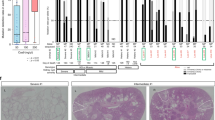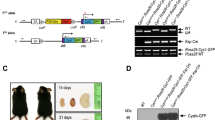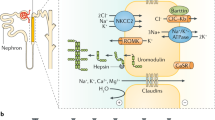Abstract
Autosomal dominant polycystic kidney disease (ADPKD) is one of the most common human genetic diseases. In addition to polycystic kidneys, the disease can cause cystic changes in liver and other organs, cardiac valvular insufficiency and cerebral arterial aneurysms. Using antibodies raised against the predicted gene product of PKD1, which is mutated in about 85% of ADPKD cases, we show that PKD1 is a 530-kD protein localized to the extracellular matrix of kidney, liver and cerebral blood vessels. We discovered that the PKD1 protein was highly expressed in the mesenchyme of developing kidney and liver, transiently localized in the developing glomerulus and juxtaglomerular apparatus and restricted to perivascular, extraglomerular areas in adult renal cortex. These data suggest that the PKD1 protein plays a role in renal and hepatic morphogenesis.
This is a preview of subscription content, access via your institution
Access options
Subscribe to this journal
Receive 12 print issues and online access
$209.00 per year
only $17.42 per issue
Buy this article
- Purchase on Springer Link
- Instant access to full article PDF
Prices may be subject to local taxes which are calculated during checkout
Similar content being viewed by others
References
Dalgaard, O.Z. Bilateral polycystic disease of the kidneys: A follow-up of two hundred and eighty-four patients and their families. Acta med. scand. 328 (suppl 1), 10–250 (1957).
Gabow, P.A. Autosomal dominant polycystic kidney disease. New Engl. J. Med
Milutinovic, J. et al. Liver cysts in patients with autosomal dominant polycystic kidney disease. Am. J. Med. 68, 741–744 (1980).
Gabow, P.A. et al. Risk factors for the development of hepatic cysts in autosomal dominant polycystic kidney disease. Hepatology 11, 1033–1032 (1990).
Leier, C.V., Baker, P.B., Kilman, J.W. & Wooley, C.F. Cardiovascular abnormalities associated with adult polycystic kidney disease. Ann. intern. Med. 100, 683–688 (1984).
Scheff, R.T., Zuckerman, G., Harter, H., Delmez, J. & Koehler, R. Diverticular disease in patients with chronic renal failure due to polycystic kidney disease. Ann. intern. Med. 92, 202–204 (1980).
Bigelow, N.H. The association of polycystic kidneys with intracranial aneurysms and other related disorders. Am. J. Med. Sci. 225, 485–494 (1953).
Baert, L. Hereditary polycystic kidney disease (adult form): A microdissection study of two cases at an early stage of the disease. Kidney Int. 13, 519–525 (1978).
European Polycystic Kidney Disease Consortium.The polycystic kidney disease 1 gene encodes a 14 kb transcript and lies within a duplicated region on chromosome 16. Cell 77, 881–894 (1994).
Chapman, A.B., Johnson, A., Gabow, P.A. & Schrier, R.W. The renin-angiotensin-aldosterone system and autosomal dominant polycystic kidney disease. New Engl. J. Med. 323, 1091–1096 (1990).
Davies, J. How to build a kidney. Semin. Cell Biol. 4, 213–219 (1993).
Abrahamson, D.R. Glomerulogenesis in the developing kidney. Semin. Nephrol. 11, 375–389, (1991).
Gabow, P.A. & Schrier, R.W. Pathophysiology of adult polycystic kidney disease. Adv. Nephrol. 18, 19–32 (1989).
Grantham, J.J. Polycystic kidney disease: Neoplasia in disguise. Am. J. Kidney Dis. 15, 110–116 (1990).
Calvet, J.P. Polycystic kidney disease: Primary extracellular matrix abnormality or defective cellular differentiation? Kidney Int. 43, 101–108 (1993).
Wilson, P.D. & Burrow, C.R. Autosomal dominant polycystic kidney disease: Cellular and molecular mechanisms of cyst formation. Adv. Nephrol. Necker. Hosp. 21, 125–142 (1992).
Evan, A.P., Gardner, K.D., Jr & Bernstein, J. Polypoid and papillary epithelial hyperplasia: A potential cause of ductal obstruction in adult polycystic kidney disease. Kidney Int. 16, 743–750 (1979).
Grantham, J.J., Geiser, J.L. & Evan, A.P. Cyst formation and growth in autosomal dominant polycystic kidney disease. Kidney Int. 31, 1145–1152 (1987).
Wilson, P.D. Aberrant epithelial cell growth in autosomal dominant polycystic kidney disease. Am. J. Kidney Dis. 17, 634–637 (1991).
Nadasdy, T. et al. Proliferative activity of cyst epithelium human renal cystic diseases. J. Am. Soc. Nephrol. 5, 1462–1468 (1995).
Grantham, J.J., Ye, M., GaHone, V.H. & Sullivan, L.P. In vitro fluid secretion by epithelium from polycystic kidneys. J. clin. Invest. 95, 195–202 (1995).
Wilson, P.D. et al. Reversed polarity of Na (+)-K (+)-ATPase: mislocation to apical plasma membranes in polycystic kidney disease epithelia. Am. J. Physiol. 260, F420–F430 (1991).
Carone, F.A. et al. Cell polarity in human renal cystic disease. Lab. Invest. 70, 648–655 (1994).
Wilson, P.D., Hreniuk, D. & Gabow, P.A. Abnormal extracellular matrix and excessive growth of human adult polycystic kidney disease epithelia. J. Cell Physiol. 150, 360–369 (1992).
Carone, F.A., Jin, H., Nakamura, S., Kanwar, Y.S. Decreased synthesis and delayed processing of sulfated glycoproteins by cells from human polycystic kidneys. Lab. Invest. 68, 413–148 (1993).
Grantham, J.J., Donoso, V.S., Evan, A.P., Carone, F.A., Gardner, K.D. Jr. Viscoelastic properties of tubule basement membranes in experimental cystic disease. Kidney Int. 32, 187–197 (1987).
van Adelsberg, J.S., Edwards, J.C., Takito, J., Kiss, B. & Al-Awqati, Q. An induced extracellular matrix protein reverses the polarity of band 3 in intercalated epithelial cells. Cell 76, 1053–1061 (1994).
Douillard, D.Y. & Hoffman, T. Enzyme-linked immunosorbent assay for screening monoclonal antibody production using enzyme-labeled second antibody. Meth. Enzym. 92, 168–174 (1983).
Author information
Authors and Affiliations
Rights and permissions
About this article
Cite this article
van Adelsberg, J., Frank, D. The PKD1 gene produces a developmentally regulated protein in mesenchyme and vasculature. Nat Med 1, 359–364 (1995). https://doi.org/10.1038/nm0495-359
Received:
Accepted:
Issue Date:
DOI: https://doi.org/10.1038/nm0495-359
This article is cited by
-
Metabolism and mitochondria in polycystic kidney disease research and therapy
Nature Reviews Nephrology (2018)
-
Deletion of Pkd1 in renal stromal cells causes defects in the renal stromal compartment and progressive cystogenesis in the kidney
Laboratory Investigation (2017)
-
Predictions for polycystin
Nature Genetics (1995)
-
The polycystic kidney disease 1 (PKD1) gene encodes a novel protein with multiple cell recognition domains
Nature Genetics (1995)
-
Filling in the matrix of kidney disease
Nature Medicine (1995)



